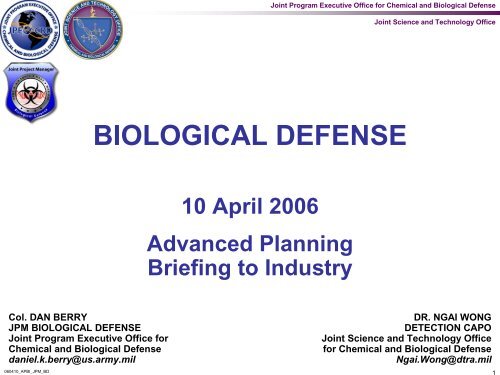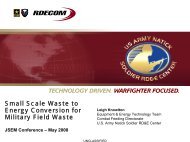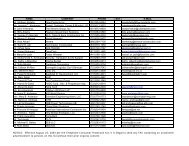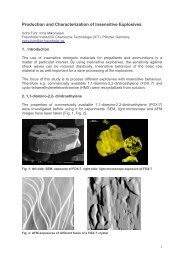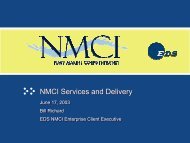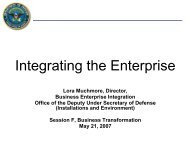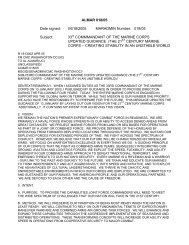BIOLOGICAL DEFENSE
BIOLOGICAL DEFENSE
BIOLOGICAL DEFENSE
Create successful ePaper yourself
Turn your PDF publications into a flip-book with our unique Google optimized e-Paper software.
Col. DAN BERRY<br />
JPM <strong>BIOLOGICAL</strong> <strong>DEFENSE</strong><br />
Joint Program Executive Office for<br />
Chemical and Biological Defense<br />
daniel.k.berry@us.army.mil<br />
Joint Program Executive Office for Chemical and Biological Defense<br />
<strong>BIOLOGICAL</strong> <strong>DEFENSE</strong><br />
10 April 2006<br />
Advanced Planning<br />
Briefing to Industry<br />
Joint Science and Technology Office<br />
DR. NGAI WONG<br />
DETECTION CAPO<br />
Joint Science and Technology Office<br />
for Chemical and Biological Defense<br />
Ngai.Wong@dtra.mil<br />
060410_APBI_JPM_BD 1
JPM Biological Defense<br />
060410_APBI_JPM_BD 2
Overarching Goals<br />
• Improve current capabilities:<br />
– Effectiveness<br />
• Increase capability for traditional & non-traditional threat agents<br />
• Increase selectivity and reduce interference<br />
– Supportability<br />
• Reduce logistics foot print<br />
• Reduce operations and support costs<br />
– Science<br />
• Threat agent science and dissemination<br />
• Sensor performance and capability<br />
• Products of Interest:<br />
– JBTDS<br />
– JBSDS<br />
060410_APBI_JPM_BD 3
• Overview<br />
• S&T and Warfighter Needs<br />
• Technical Challenges<br />
Outline<br />
• Acquisition Strategy/ Funding/ Schedule<br />
• Upcoming Business Opportunities<br />
• Contacts<br />
060410_APBI_JPM_BD 4
S&T Overview<br />
Joint Biological Tactical Detection Systems (JBTDS)<br />
• Overall Objective - Develop science and technology to<br />
detect, identify, quantify, map, and track the presence of<br />
chemical and biological warfare agents<br />
– Fundamental development of signatures<br />
– Understand the interactions of the signatures with the<br />
environment<br />
– Develop physics based models enhanced with system<br />
engineering principles to provide a virtual system<br />
• War-gaming to develop optimal system capabilities, needs, and<br />
requirements<br />
• Virtual proving ground to optimize T&E requirements<br />
060410_APBI_JPM_BD 5
S&T Overview<br />
Joint Biological Standoff Detection System (JBSDS)<br />
• Demonstrate mature technology concepts for augmenting or<br />
replacing the current technology being pursued under Increment I<br />
of the JBSDS program<br />
• Assess the merit of selectively integrating some of these<br />
technologies into a hybrid system that meets a broader subset of<br />
the Increment II specifications.<br />
• Potential Resources Include Existing and Future:<br />
– Laser Induced Fluorescence<br />
– Elastic Scatter Depolarization<br />
– Differential Elastic Scattering<br />
– Passive IR Spectroscopy<br />
– Hyperspectral Imaging<br />
– Algorithm Development<br />
– Technology Modeling<br />
060410_APBI_JPM_BD 6
Program Overview<br />
Joint Biological Tactical Detection Systems (JBTDS)<br />
• Program seeks to provide a light weight, low cost biological<br />
aerosol detection and sampling capability to the Joint Force.<br />
– FY07 New Start<br />
– Technology Readiness Evaluation (TRE) Planned 3rd-4th Qtr FY08<br />
– May adopt a Family of Systems approach<br />
• Proposed Expeditionary Biological Detection (EBD) Advanced<br />
Technology Demonstration (ATD) supports JBTDS by:<br />
– Developing Concepts of Operations for tactical biological detectors<br />
– Clarifying requirements and systems engineering tradeoffs<br />
– Conducting Military Utility Assessment (MUA) of emerging technologies<br />
060410_APBI_JPM_BD 7
Program Overview<br />
Joint Biological Standoff Detection System (JBSDS)<br />
• JBSDS Increment 2 will be employed to provide mobile<br />
on the move detection of biological hazards employed<br />
by various means and will provide early warning via the<br />
Joint Warning and Reporting Network (JWARN).<br />
• Essential Resources Include Existing and Future:<br />
– Mobile Detectors (Vehicles, Ships, Unmanned Platforms)<br />
– Fixed Site/Static Detectors (Buildings, Vehicles)<br />
060410_APBI_JPM_BD 8
S&T Needs<br />
Joint Biological Tactical Detection Systems (JBTDS)<br />
• Development of new sources and detectors<br />
– Optimal performance at room temperature<br />
– Low cost, solid state<br />
• Development of physics based models enhanced with<br />
system engineering principles to provide a virtual<br />
system<br />
060410_APBI_JPM_BD 9
S&T Needs<br />
Joint Biological Standoff Detection System (JBSDS)<br />
• Algorithm development<br />
– Improvement of detection and discrimination algorithms<br />
• Spectral vs. narrow band fluorescence data<br />
• Eye safe energies to increase system use in different<br />
environments<br />
• Biological signature data collection and background<br />
data collection<br />
• Prototype/test bed development<br />
060410_APBI_JPM_BD 10
Warfighter Needs<br />
Joint Biological Tactical Detection Systems (JBTDS)<br />
• Rapid, automated detection of biological events<br />
• Organically deployable, employable, and supportable<br />
– Reduce size and weight of systems/components<br />
– Reduce logistical footprint<br />
– Modular components for flexible integration<br />
– Simplified operation for unrestricted Military Occupational<br />
Specialties (MOS)<br />
• JBTDS MS A will be based on the CBRN Sensors for<br />
Unmanned Applications ICD signed February 23, 2006<br />
060410_APBI_JPM_BD 11
Warfighter Needs<br />
Joint Biological Standoff Detection System (JBSDS)<br />
• Ability to safely operate, survive and sustain operations<br />
in a biological agent threat area<br />
• Defense from worldwide proliferation of biological<br />
warfare capabilities<br />
• Detection of biological threat agents to provide early<br />
warning capabilities at mobile and fixed operating<br />
locations, mobile dismounted forces, naval and air<br />
platforms, during both day and night operations<br />
060410_APBI_JPM_BD 12
S&T Technical Challenges<br />
Joint Biological Tactical Detection Systems (JBTDS)<br />
• Low cost, solid state replacement for photomultiplier<br />
tubes<br />
• Enhance component life on excitation sources<br />
• Direct electron pumped excitations sources (below<br />
300nm)<br />
060410_APBI_JPM_BD 13
S&T Technical Challenges<br />
Joint Biological Standoff Detection System (JBSDS)<br />
• Decreasing system size and weight while increasing<br />
detection and discrimination sensitivities<br />
• Algorithm development<br />
– Decreasing false alarm rates<br />
– Robustness to handle I-2 requirements and future capabilities<br />
• Modeling promising and future technologies<br />
060410_APBI_JPM_BD 14
Program Technical Challenges<br />
Joint Biological Tactical Detection Systems (JBTDS)<br />
• Operationally significant capability within tactical<br />
constraints<br />
– Sensitivity and False Alarm Rates<br />
– Size/Weight/Power tradeoffs<br />
– Rugged design for full range of environments and operational<br />
temperature range<br />
– Life cycle cost<br />
– Next-generation battery technology to extend mission life<br />
– Built in Test / Confidence checkers to increase availability<br />
060410_APBI_JPM_BD 15
Program Technical Challenges<br />
Joint Biological Standoff Detection System (JBSDS)<br />
• Suitable detection and discrimination sensitivities and ranges<br />
based on validated threat assessment<br />
• Low false alarm rate<br />
• Day/night capability<br />
• System robustness to handle future biological threats<br />
• Integration into future platform and systems - Modular Design<br />
• CONOPS for future biological standoff<br />
• Comprehensive testing of future systems<br />
060410_APBI_JPM_BD 16
• JBTDS<br />
S&T Capability Strategy<br />
– Solid state components for excitation sources and detector<br />
elements<br />
• LEDS below 300nm<br />
• Direct electron pumped sources below 300nm<br />
– Molded plastic optics<br />
– Virtual models based on first principles linked with system<br />
engineering concepts<br />
• JBSDS<br />
– Development of signatures for exploitation<br />
– Algorithms to take advantage of signatures<br />
– Imaging technology<br />
– Virtual models based on first principles linked with system<br />
engineering concepts<br />
060410_APBI_JPM_BD 17
Program Acquisition Strategy<br />
Joint Biological Tactical Detection Systems (JBTDS)<br />
• System of Systems / Family of Systems approach:<br />
– Multiple detection and sampling systems optimized for cost, weight,<br />
and power<br />
– Range of capability across the family:<br />
• Speed: Time to detect 1 min – 30 min<br />
• Information: Bio/non-bio, class-based ID, presumptive ID<br />
• Sensitivity<br />
• Confidence<br />
• Breadth of threat detected: 1 agent – many traditional and non-traditional<br />
agents<br />
• Spiral Development and Acquisition<br />
– Field increments of capability for each family member as technology<br />
matures<br />
• Based on Marine Corps requirement for a man-portable modular<br />
system<br />
• Conduct ATD FY06-08 to evaluate available technology<br />
• In parallel with ATD develop CDD and prepare for Milestone B<br />
• Select technology for JBTDS based on ATD results<br />
060410_APBI_JPM_BD 18
Program Acquisition Strategy<br />
Joint Biological Standoff Detection System (JBSDS)<br />
• Joint Service Acquisition with 4 Service interest<br />
– Smaller, more sensitive version of JBSDS Increment 1 with a<br />
lower false alarm rate that operates on the move and during the<br />
day & night<br />
• Assess multiple technologies to determine the synergy<br />
with Increment 1 technology<br />
• Develop concepts to address Future Combat System<br />
and UAV platforms that integrate other battlefield/CB<br />
sensor data<br />
• Perform requirements assessment and trade off<br />
analysis in conjunction with JRO/Combat Developers<br />
– To validate CDD requirements<br />
– To develop CONOPS and employment architecture<br />
• Award competitive SDD contract to integrate<br />
improvements/other technologies with LRIP and<br />
production options<br />
060410_APBI_JPM_BD 19
S&T Funding<br />
($M) FY06 FY07 FY08 FY09 FY10 FY11 TOTALS<br />
6.2 4.7 4.0 5.0 5.0 18.7<br />
6.3 12.0 12.0 8.0 32.0<br />
TOTAL 16.7 16.0 13.0 5.0 50.7<br />
060410_APBI_JPM_BD 20
Program Funding<br />
($M) FY06 FY07 FY08 FY09 FY10 FY11 TOTALS<br />
6.4 1.0 6.0 7.2 14.2<br />
6.5 9.9 13.0 18.1 16.6 5.0 62.6<br />
Proc 10.2 10.2<br />
TOTAL 9.9 14.0 24.1 23.8 15.2 87.0<br />
060410_APBI_JPM_BD 21
Lt. wt. CB Detector<br />
Low Cost/LBADS<br />
TRE<br />
EBD ATD<br />
S&T Schedule<br />
Joint Biological Tactical Detection Systems (JBTDS)<br />
MS A MS B<br />
Advanced Technology<br />
Demonstration (ATD) –<br />
Expeditionary Biological Detection<br />
(EBD)<br />
FY06 FY07 FY08 FY09 FY10 FY11 FY12 FY13<br />
Joint Biological Standoff Detection Systems (JBSDS) Incr 2<br />
DISC/DIAL<br />
Polarization<br />
Downselect<br />
TRE<br />
FY06 FY07 FY08 FY09 FY10 FY11 FY12 FY13<br />
060410_APBI_JPM_BD 22
ICD ICD<br />
Market<br />
Survey<br />
SETS<br />
CDD Dev.<br />
SDD<br />
CPD Dev.<br />
LRIP<br />
DT/OT<br />
Program Schedule<br />
Joint Biological Tactical Detection Systems (JBTDS)<br />
ICD MS A MS B MS C FRP IOC FOC<br />
MS B Doc<br />
Prep<br />
Production<br />
FY06 FY07 FY08 FY09 FY10 FY11 FY12 FY13<br />
Joint Biological Standoff Detection Systems (JBSDS) Incr 2<br />
SDD<br />
LRIP<br />
FY06 FY07 FY08 FY09 FY10 FY11 FY12 FY13<br />
060410_APBI_JPM_BD 23<br />
MS B<br />
MS C<br />
4
Upcoming Business Opportunities<br />
Joint Biological Tactical Detection Systems (JBTDS)<br />
• Expeditionary Biological Detection (EBD) ATD<br />
– RFP 4th Qtr FY06<br />
• Joint Biological Tactical Detection System (JBTDS)<br />
– Technology Readiness Evaluation RFP 2nd Qtr FY08<br />
Joint Biological Standoff Detection System (JBSDS)<br />
• Technology Readiness Assessment FY08<br />
• RFP For System Development and Demo FY09<br />
• Techbase – SBIR FY07 – 09<br />
• Techbase – CBDIF FY06 – 09<br />
• Techbase – S&T BAA FY08 – 10<br />
S&T Opportunities<br />
060410_APBI_JPM_BD 24
S&T Points of Contact<br />
• Dr. Ngai Wong, Detection CAPO, 703-767-3314, S&T,<br />
Ngai.Wong@dtra.mil<br />
060410_APBI_JPM_BD 25
Program Points of Contact<br />
• LTC Dennis Card, JPM-BDS, 410-436-7729,<br />
JBTDS/JBSDS, dennis.card@us.army.mil<br />
• Ken Kammerer, JBSDS PM, 410-436-5523, JBSDS,<br />
ken.kammerer@us.army.mil<br />
• John Strawbridge, Inc. II Lead Sys Eng, 410-436-5915,<br />
JBSDS, john.strawbridge@us.army.mil<br />
• Mike Mays, Physical Scientist, 410-426-6663, JBSDS,<br />
robert.m.mays@us.army.mil<br />
• Cindy Swim, DTO Manager, 410-436-6626, JBSDS,<br />
cynthia.swim@us.army.mil<br />
• Adam Becker, JBTDS Team Leader, 703-432-3210,<br />
JBTDS, adam.j.becker1@usmc.mil<br />
060410_APBI_JPM_BD 26


